charging MITSUBISHI OUTLANDER PHEV 2014 (in English) Workshop Manual
[x] Cancel search | Manufacturer: MITSUBISHI, Model Year: 2014, Model line: OUTLANDER PHEV, Model: MITSUBISHI OUTLANDER PHEV 2014Pages: 442, PDF Size: 19.04 MB
Page 213 of 442
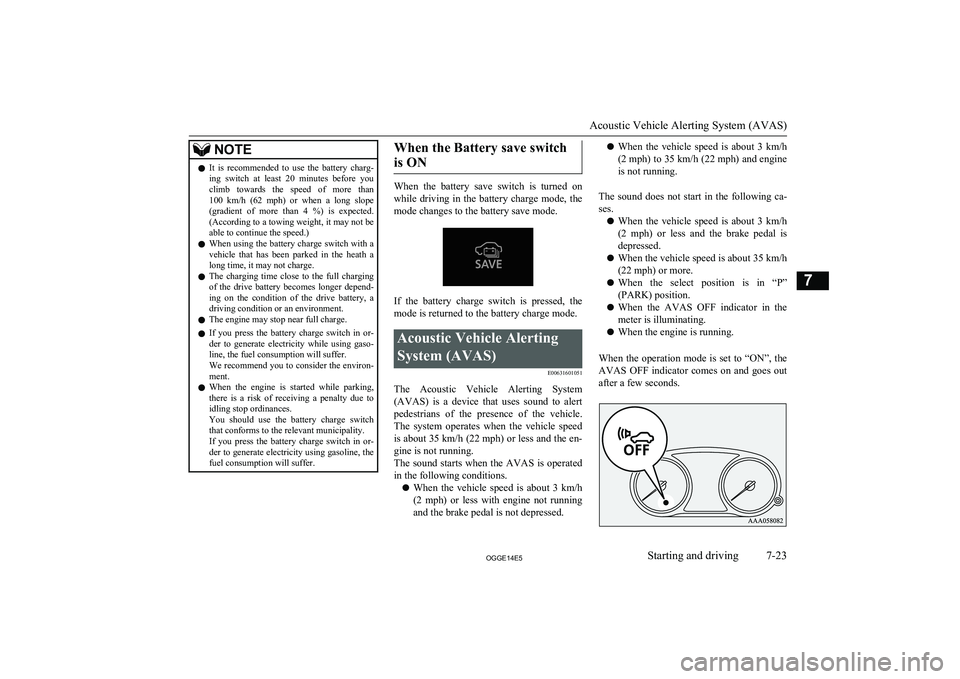
NOTElIt is recommended to use the battery charg-
ing switch at least 20 minutes before you
climb towards the speed of more than
100 km/h (62 mph) or when a long slope
(gradient of more than 4 %) is expected.
(According to a towing weight, it may not be able to continue the speed.)
l When using the battery charge switch with a
vehicle that has been parked in the heath a
long time, it may not charge.
l The charging time close to the full charging
of the drive battery becomes longer depend- ing on the condition of the drive battery, a
driving condition or an environment.
l The engine may stop near full charge.
l If you press the battery charge switch in or-
der to generate electricity while using gaso-
line, the fuel consumption will suffer. We recommend you to consider the environ- ment.
l When the engine is started while parking,
there is a risk of receiving a penalty due to
idling stop ordinances.
You should use the battery charge switch that conforms to the relevant municipality.
If you press the battery charge switch in or-
der to generate electricity using gasoline, the fuel consumption will suffer.When the Battery save switch
is ON
When the battery save switch is turned on while driving in the battery charge mode, the
mode changes to the battery save mode.
If the battery charge switch is pressed, the
mode is returned to the battery charge mode.
Acoustic Vehicle Alerting
System (AVAS) E00631601051
The Acoustic Vehicle Alerting System(AVAS) is a device that uses sound to alert
pedestrians of the presence of the vehicle. The system operates when the vehicle speed
is about 35 km/h (22 mph) or less and the en-
gine is not running.
The sound starts when the AVAS is operated
in the following conditions.
l When the vehicle speed is about 3 km/h
(2 mph) or less with engine not runningand the brake pedal is not depressed.
l When the vehicle speed is about 3 km/h
(2 mph) to 35 km/h (22 mph) and engine
is not running.
The sound does not start in the following ca-
ses.
l When the vehicle speed is about 3 km/h
(2 mph) or less and the brake pedal is depressed.
l When the vehicle speed is about 35 km/h
(22 mph) or more.
l When the select position is in “P”
(PARK) position.
l When the AVAS OFF indicator in the
meter is illuminating.
l When the engine is running.
When the operation mode is set to “ON”, the
AVAS OFF indicator comes on and goes out after a few seconds.
Acoustic Vehicle Alerting System (AVAS)
7-23OGGE14E5Starting and driving7
Page 373 of 442
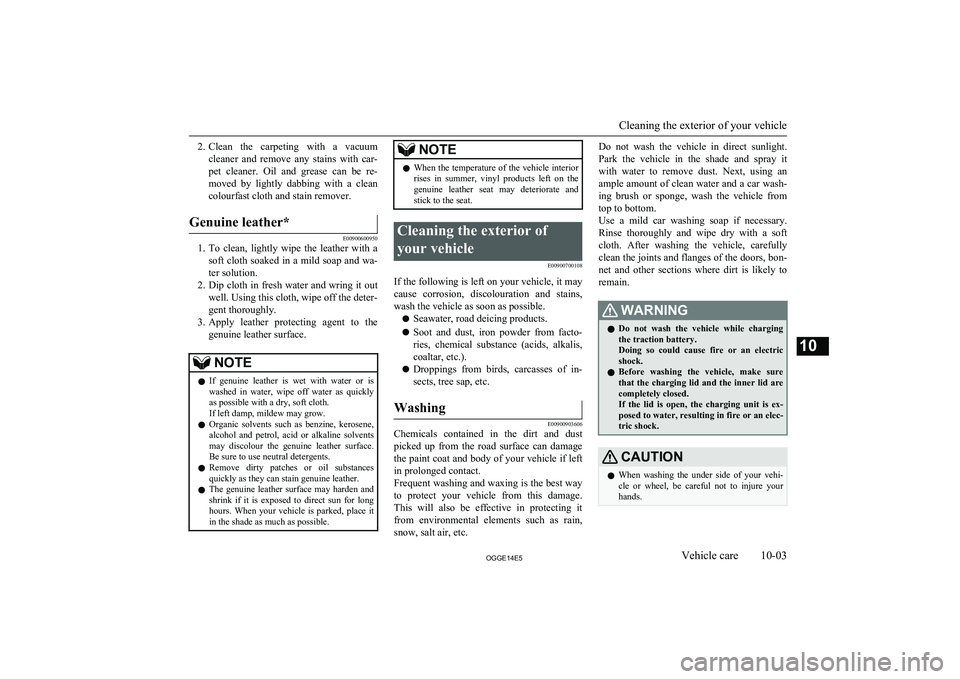
2.Clean the carpeting with a vacuum
cleaner and remove any stains with car- pet cleaner. Oil and grease can be re- moved by lightly dabbing with a cleancolourfast cloth and stain remover.Genuine leather*
E00900600950
1. To clean, lightly wipe the leather with a
soft cloth soaked in a mild soap and wa-
ter solution.
2. Dip cloth in fresh water and wring it out
well. Using this cloth, wipe off the deter-
gent thoroughly.
3. Apply leather protecting agent to the
genuine leather surface.
NOTEl If genuine leather is wet with water or is
washed in water, wipe off water as quickly
as possible with a dry, soft cloth.
If left damp, mildew may grow.
l Organic solvents such as benzine, kerosene,
alcohol and petrol, acid or alkaline solvents
may discolour the genuine leather surface. Be sure to use neutral detergents.
l Remove dirty patches or oil substances
quickly as they can stain genuine leather.
l The genuine leather surface may harden and
shrink if it is exposed to direct sun for long
hours. When your vehicle is parked, place it in the shade as much as possible.NOTEl When the temperature of the vehicle interior
rises in summer, vinyl products left on the
genuine leather seat may deteriorate and stick to the seat.Cleaning the exterior of
your vehicle E00900700108
If the following is left on your vehicle, it maycause corrosion, discolouration and stains, wash the vehicle as soon as possible.
l Seawater, road deicing products.
l Soot and dust, iron powder from facto-
ries, chemical substance (acids, alkalis, coaltar, etc.).
l Droppings from birds, carcasses of in-
sects, tree sap, etc.
Washing
E00900903606
Chemicals contained in the dirt and dustpicked up from the road surface can damagethe paint coat and body of your vehicle if left
in prolonged contact.
Frequent washing and waxing is the best way to protect your vehicle from this damage.
This will also be effective in protecting it from environmental elements such as rain,snow, salt air, etc.
Do not wash the vehicle in direct sunlight.
Park the vehicle in the shade and spray it
with water to remove dust. Next, using an ample amount of clean water and a car wash- ing brush or sponge, wash the vehicle from
top to bottom.
Use a mild car washing soap if necessary.
Rinse thoroughly and wipe dry with a soft
cloth. After washing the vehicle, carefully clean the joints and flanges of the doors, bon-
net and other sections where dirt is likely to remain.WARNINGl Do not wash the vehicle while charging
the traction battery.
Doing so could cause fire or an electric shock.
l Before washing the vehicle, make sure
that the charging lid and the inner lid are completely closed.
If the lid is open, the charging unit is ex- posed to water, resulting in fire or an elec-
tric shock.CAUTIONl When washing the under side of your vehi-
cle or wheel, be careful not to injure your hands.
Cleaning the exterior of your vehicle
10-03OGGE14E5Vehicle care10
Page 374 of 442
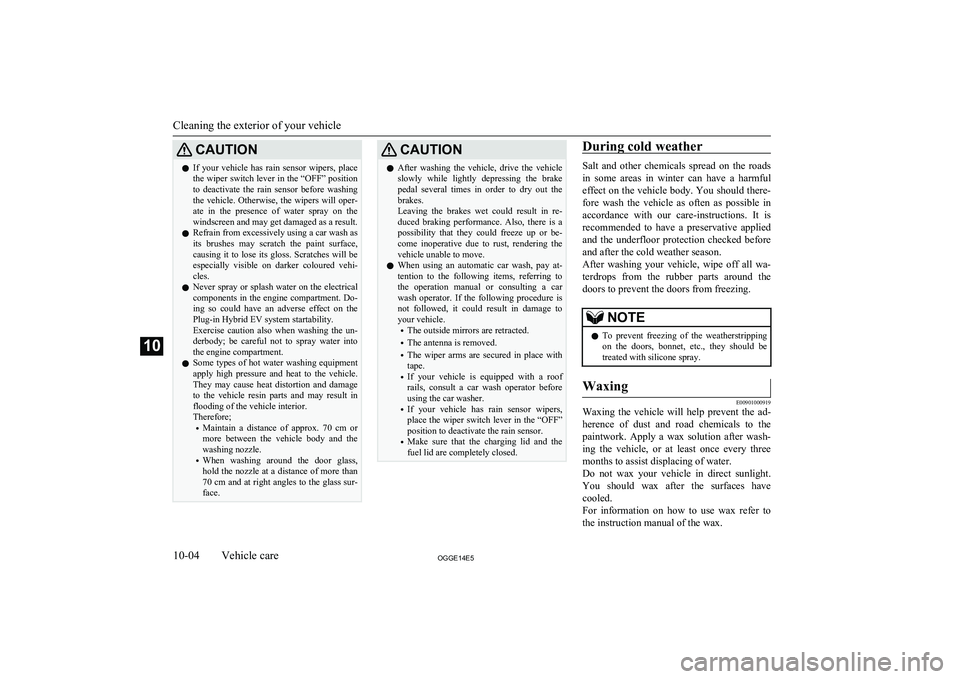
CAUTIONlIf your vehicle has rain sensor wipers, place
the wiper switch lever in the “OFF” position
to deactivate the rain sensor before washing the vehicle. Otherwise, the wipers will oper-ate in the presence of water spray on the
windscreen and may get damaged as a result.
l Refrain from excessively using a car wash as
its brushes may scratch the paint surface, causing it to lose its gloss. Scratches will be
especially visible on darker coloured vehi-
cles.
l Never spray or splash water on the electrical
components in the engine compartment. Do-
ing so could have an adverse effect on the
Plug-in Hybrid EV system startability.
Exercise caution also when washing the un- derbody; be careful not to spray water intothe engine compartment.
l Some types of hot water washing equipment
apply high pressure and heat to the vehicle.They may cause heat distortion and damage
to the vehicle resin parts and may result in
flooding of the vehicle interior.
Therefore;
• Maintain a distance of approx. 70 cm or
more between the vehicle body and the
washing nozzle.
• When washing around the door glass,
hold the nozzle at a distance of more than
70 cm and at right angles to the glass sur-
face.CAUTIONl After washing the vehicle, drive the vehicle
slowly while lightly depressing the brake
pedal several times in order to dry out the
brakes.
Leaving the brakes wet could result in re- duced braking performance. Also, there is a possibility that they could freeze up or be-
come inoperative due to rust, rendering the vehicle unable to move.
l When using an automatic car wash, pay at-
tention to the following items, referring to the operation manual or consulting a car
wash operator. If the following procedure is not followed, it could result in damage to
your vehicle.
• The outside mirrors are retracted.
• The antenna is removed.
• The wiper arms are secured in place with
tape.
• If your vehicle is equipped with a roof
rails, consult a car wash operator before using the car washer.
• If your vehicle has rain sensor wipers,
place the wiper switch lever in the “OFF” position to deactivate the rain sensor.
• Make sure that the charging lid and the
fuel lid are completely closed.During cold weather
Salt and other chemicals spread on the roads
in some areas in winter can have a harmful effect on the vehicle body. You should there-
fore wash the vehicle as often as possible in accordance with our care-instructions. It is
recommended to have a preservative applied
and the underfloor protection checked before and after the cold weather season.
After washing your vehicle, wipe off all wa- terdrops from the rubber parts around the
doors to prevent the doors from freezing.
NOTEl To prevent freezing of the weatherstripping
on the doors, bonnet, etc., they should be treated with silicone spray.Waxing
E00901000919
Waxing the vehicle will help prevent the ad-
herence of dust and road chemicals to the paintwork. Apply a wax solution after wash- ing the vehicle, or at least once every three
months to assist displacing of water.
Do not wax your vehicle in direct sunlight.
You should wax after the surfaces have
cooled.
For information on how to use wax refer to the instruction manual of the wax.
Cleaning the exterior of your vehicle
10-04OGGE14E5Vehicle care10
Page 378 of 442
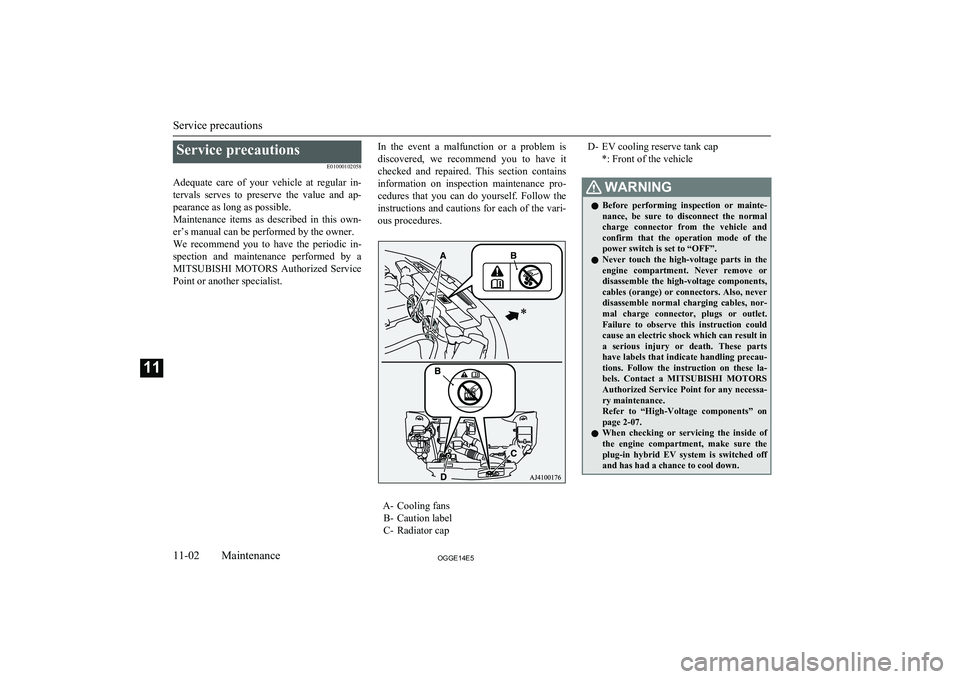
Service precautionsE01000102058
Adequate care of your vehicle at regular in- tervals serves to preserve the value and ap-
pearance as long as possible.
Maintenance items as described in this own- er’s manual can be performed by the owner.We recommend you to have the periodic in-
spection and maintenance performed by a MITSUBISHI MOTORS Authorized Service
Point or another specialist.In the event a malfunction or a problem is discovered, we recommend you to have it
checked and repaired. This section contains information on inspection maintenance pro- cedures that you can do yourself. Follow theinstructions and cautions for each of the vari-
ous procedures.
A- Cooling fans B- Caution label
C- Radiator cap
D- EV cooling reserve tank cap
*: Front of the vehicleWARNINGlBefore performing inspection or mainte-
nance, be sure to disconnect the normal charge connector from the vehicle andconfirm that the operation mode of the power switch is set to “OFF”.
l Never touch the high-voltage parts in the
engine compartment. Never remove or disassemble the high-voltage components,
cables (orange) or connectors. Also, never disassemble normal charging cables, nor-
mal charge connector, plugs or outlet. Failure to observe this instruction could
cause an electric shock which can result in
a serious injury or death. These parts have labels that indicate handling precau-
tions. Follow the instruction on these la- bels. Contact a MITSUBISHI MOTORS
Authorized Service Point for any necessa-
ry maintenance.
Refer to “High-Voltage components” on page 2-07.
l When checking or servicing the inside of
the engine compartment, make sure the
plug-in hybrid EV system is switched off and has had a chance to cool down.
Service precautions
11-02OGGE14E5Maintenance11
Page 409 of 442
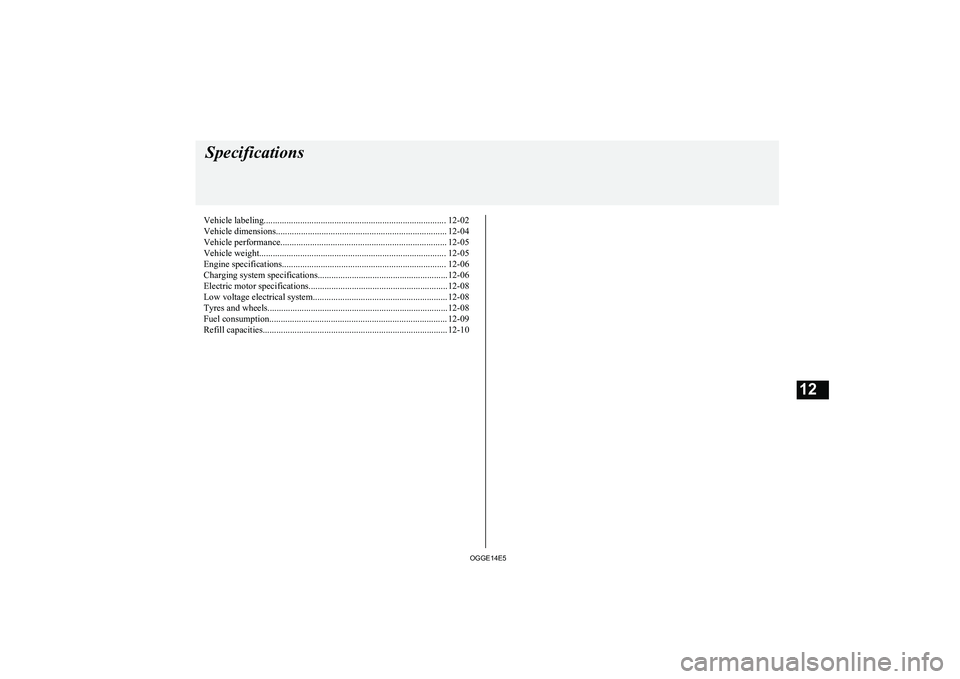
Vehicle labeling................................................................................ 12-02
Vehicle dimensions........................................................................... 12-04
Vehicle performance......................................................................... 12-05 Vehicle weight.................................................................................. 12-05
Engine specifications........................................................................ 12-06
Charging system specifications.........................................................12-06
Electric motor specifications.............................................................12-08
Low voltage electrical system........................................................... 12-08Tyres and wheels...............................................................................12-08
Fuel consumption.............................................................................. 12-09
Refill capacities................................................................................. 12-10Specifications
OGGE14E512
Page 414 of 442
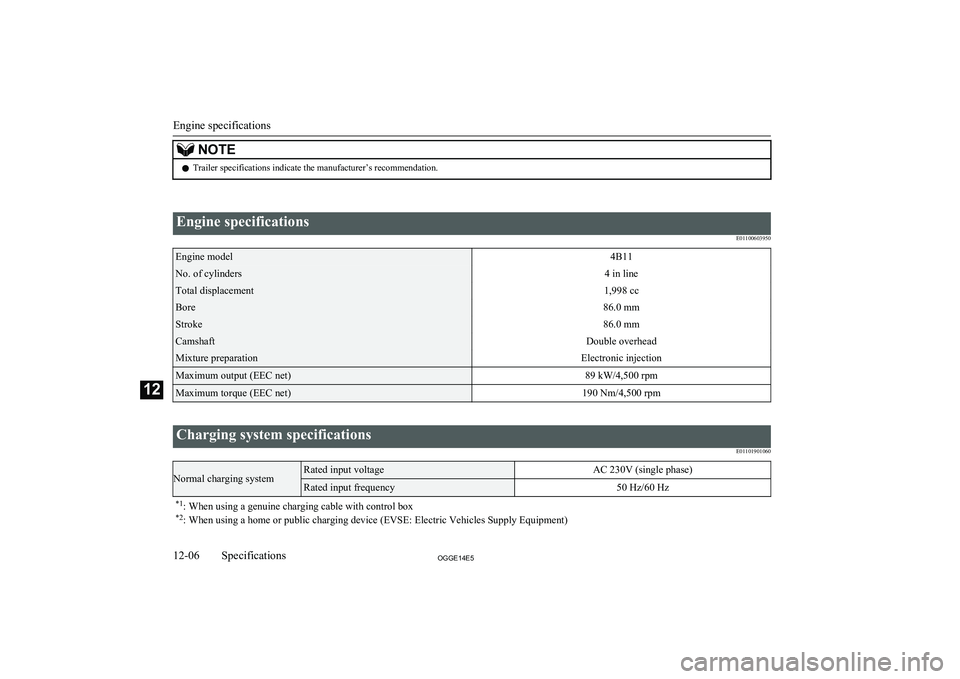
NOTElTrailer specifications indicate the manufacturer’s recommendation.
Engine specifications
E01100603950Engine model4B11No. of cylinders4 in lineTotal displacement1,998 ccBore86.0 mmStroke86.0 mmCamshaftDouble overheadMixture preparationElectronic injectionMaximum output (EEC net)89 kW/4,500 rpmMaximum torque (EEC net)190 Nm/4,500 rpm
Charging system specifications E01101901060Normal charging systemRated input voltageAC 230V (single phase)Rated input frequency50 Hz/60 Hz*1: When using a genuine charging cable with control box
*2 : When using a home or public charging device (EVSE: Electric Vehicles Supply Equipment)
Engine specifications
12-06OGGE14E5Specifications12
Page 415 of 442
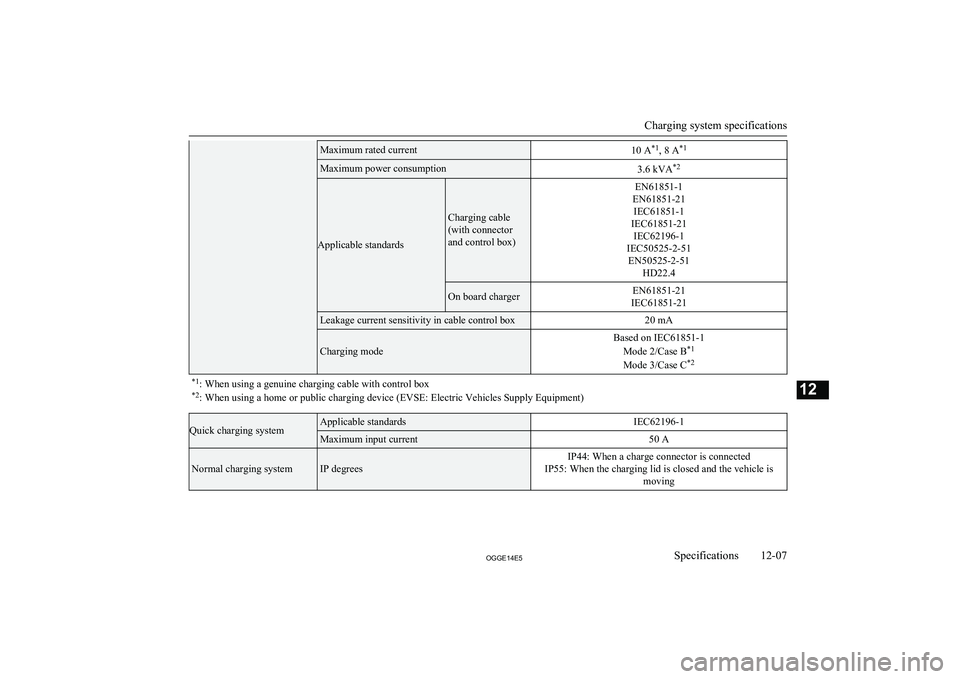
Maximum rated current10 A*1
, 8 A *1Maximum power consumption3.6 kVA *2
Applicable standards
Charging cable
(with connector
and control box)
EN61851-1
EN61851-21 IEC61851-1
IEC61851-21 IEC62196-1
IEC50525-2-51 EN50525-2-51 HD22.4On board chargerEN61851-21
IEC61851-21Leakage current sensitivity in cable control box20 mA
Charging mode
Based on IEC61851-1
Mode 2/Case B *1
Mode 3/Case C *2*1
: When using a genuine charging cable with control box
*2 : When using a home or public charging device (EVSE: Electric Vehicles Supply Equipment)
Quick charging systemApplicable standardsIEC62196-1Maximum input current50 A
Normal charging systemIP degrees
IP44: When a charge connector is connected
IP55: When the charging lid is closed and the vehicle is moving
Charging system specifications
12-07OGGE14E5Specifications12
Page 421 of 442
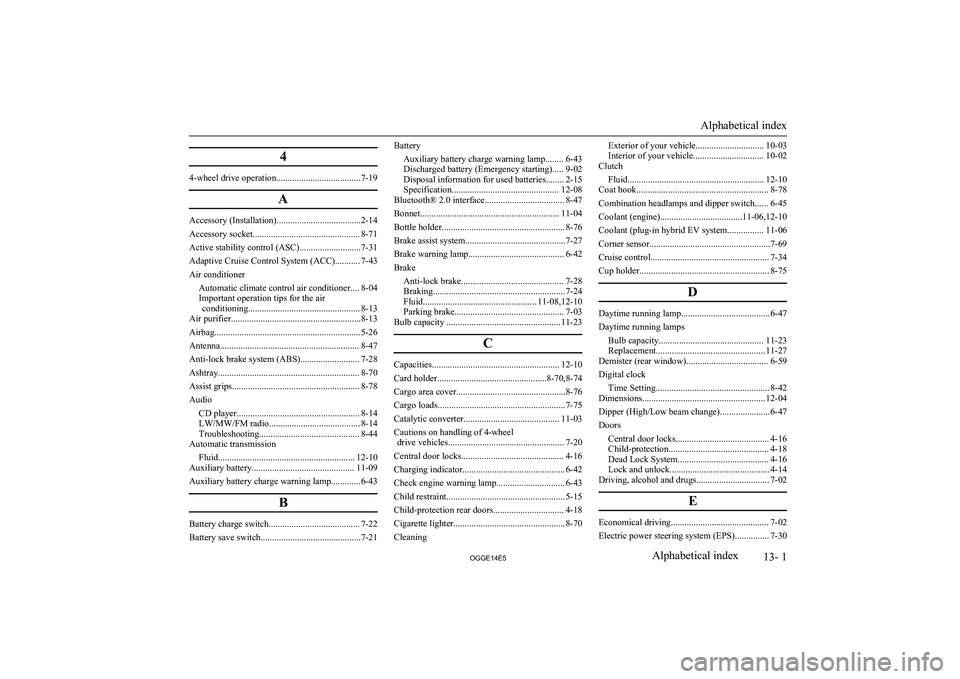
4
4-wheel drive operation.....................................7-19A
Accessory (Installation).....................................2-14
Accessory socket............................................... 8-71
Active stability control (ASC)...........................7-31
Adaptive Cruise Control System (ACC)........... 7-43
Air conditioner Automatic climate control air conditioner.... 8-04
Important operation tips for the air conditioning................................................. 8-13
Air purifier.........................................................8-13
Airbag................................................................ 5-26
Antenna............................................................. 8-47
Anti-lock brake system (ABS).......................... 7-28
Ashtray.............................................................. 8-70
Assist grips........................................................ 8-78
Audio CD player...................................................... 8-14
LW/MW/FM radio........................................ 8-14
Troubleshooting............................................ 8-44
Automatic transmission
Fluid............................................................ 12-10
Auxiliary battery............................................. 11-09
Auxiliary battery charge warning lamp.............6-43
B
Battery charge switch........................................ 7-22
Battery save switch............................................7-21
Battery Auxiliary battery charge warning lamp........ 6-43
Discharged battery (Emergency starting)..... 9-02
Disposal information for used batteries........ 2-15 Specification............................................... 12-08
Bluetooth® 2.0 interface................................... 8-47
Bonnet............................................................. 11-04
Bottle holder...................................................... 8-76
Brake assist system............................................7-27
Brake warning lamp.......................................... 6-42
Brake Anti-lock brake............................................. 7-28
Braking.......................................................... 7-24
Fluid.................................................. 11-08,12-10
Parking brake................................................ 7-03
Bulb capacity .................................................. 11-23
C
Capacities........................................................ 12-10
Card holder................................................8-70,8-74
Cargo area cover................................................8-76
Cargo loads........................................................7-75
Catalytic converter.......................................... 11-03
Cautions on handling of 4-wheel drive vehicles................................................... 7-20
Central door locks............................................. 4-16
Charging indicator............................................. 6-42
Check engine warning lamp.............................. 6-43
Child restraint.................................................... 5-15
Child-protection rear doors............................... 4-18
Cigarette lighter................................................. 8-70
Cleaning
Exterior of your vehicle.............................. 10-03 Interior of your vehicle............................... 10-02
Clutch
Fluid............................................................ 12-10
Coat hook.......................................................... 8-78
Combination headlamps and dipper switch...... 6-45
Coolant (engine)....................................11-06,12-10
Coolant (plug-in hybrid EV system................ 11-06
Corner sensor.....................................................7-69
Cruise control.................................................... 7-34
Cup holder......................................................... 8-75
D
Daytime running lamp.......................................6-47
Daytime running lamps Bulb capacity.............................................. 11-23
Replacement................................................ 11-27
Demister (rear window).................................... 6-59
Digital clock Time Setting.................................................. 8-42
Dimensions...................................................... 12-04
Dipper (High/Low beam change)......................6-47
Doors Central door locks......................................... 4-16
Child-protection............................................ 4-18
Dead Lock System........................................ 4-16
Lock and unlock............................................ 4-14
Driving, alcohol and drugs................................ 7-02
E
Economical driving........................................... 7-02
Electric power steering system (EPS)............... 7-30
Alphabetical index
13- 1
OGGE14E5Alphabetical index